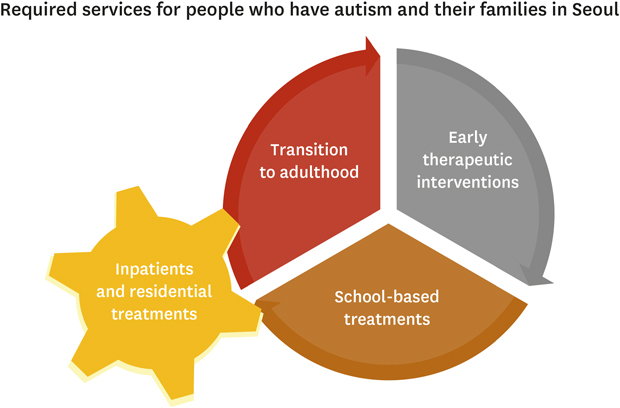1. American Psychiatric Association. Diagnostic and Statistical Manual of Mental Disorders. 5th ed. Washington, D.C.: American Psychiatric Association;2013.
2. Baio J, Wiggins L, Christensen DL, Maenner MJ, Daniels J, Warren Z, et al. Prevalence of autism spectrum disorder among children aged 8 years - Autism and Developmental Disabilities Monitoring Network, 11 Sites, United States, 2014. MMWR Surveill Summ. 2018; 67(6):1–23.

3. Piskorz-Ogórek K, Ogórek S, Cieślińska A Kostyra E. Autism in Poland in comparison to other countries. Pol Ann Med. 2015; 22(1):35–40.

4. Kim YS, Leventhal BL, Koh YJ, Fombonne E, Laska E, Lim EC, et al. Prevalence of autism spectrum disorders in a total population sample. Am J Psychiatry. 2011; 168(9):904–912.

6. Hong M, Lee SY, Han J, Park JC, Lee YJ, Hwangbo R, et al. Prescription trends of psychotropics in children and adolescents with autism based on nationwide health insurance data. J Korean Med Sci. 2017; 32(10):1687–1693.

7. Zwaigenbaum L, Bauman ML, Fein D, Pierce K, Buie T, Davis PA, et al. Early screening of autism spectrum disorder: recommendations for practice and research. Pediatrics. 2015; 136 Suppl 1:S41–S59.

8. Volkmar F, Siegel M, Woodbury-Smith M, King B, McCracken J, State M, et al. Practice parameter for the assessment and treatment of children and adolescents with autism spectrum disorder. J Am Acad Child Adolesc Psychiatry. 2014; 53(2):237–257.

9. Payakachat N, Tilford JM, Kuhlthau KA. Parent-reported use of interventions by toddlers and preschoolers with autism spectrum disorder. Psychiatr Serv. 2018; 69(2):186–194.

10. Locke J, Kang-Yi CD, Pellecchia M, Marcus S, Hadley T, Mandell DS. Ethnic disparities in school-based behavioral health service use for children with psychiatric disorders. J Sch Health. 2017; 87(1):47–54.

11. Sun X, Allison C, Auyeung B, Baron-Cohen S, Brayne C. A review of healthcare service and education provision of Autism Spectrum Condition in mainland China. Res Dev Disabil. 2013; 34(1):469–479.

17. National Institute of Special Education. Special Education Statistics, School Year 2017. Seoul, Korea: Ministry of Education;2017.
19. Lee JY, Moon DS, Shin SH, Yoo HJ, Byun HJ, Suh DS. A survey on the status of hospital-based early intensive intervention for autism spectrum disorder in South Korea. J Korean Acad Child Adolesc Psychiatry. 2017; 28(4):213–219.

20. Seoul Metropolitan Children's Hospital, Center for Autism and Neurodevelopmental Disorder. A Guide for Developmental Disorder Treatment Facilities. Seoul, Korea: Seoul Metropolitan Children's Hospital;2017.
21. The Economist Intelligence Unit. Worldwide Cost of Living 2018: Which Global Cities Have the Highest Cost of Living? New York, NY: The Economist Intelligence Unit;2018.
23. Massachusetts Department of Elementary and Secondary Education. School and district profiles. Accessed June 23, 2018.
http://profiles.doe.mass.edu.
24. Gabovitch EM, Lauer E, Dutra C. Healthy People 2020 Roadmap Report for Massachusetts Children and Youth with ASD/DD: Understanding Needs and Measuring Outcomes. Boston, MA: University of Massachusetts Medical School, E.K. Shriver Center;2016.
27. Massachusetts Psychiatric Society. Massachusetts Board of Registration in Medicine (Email communication on June 9, 2018). 2018.
34. The 106th United States Congress. Children's Health Act of 2000. GovTrack H.R. 4365. Washington D.C.: GovTrack;2000.
35. Lundström S, Reichenberg A, Anckarsäter H, Lichtenstein P, Gillberg C. Autism phenotype versus registered diagnosis in Swedish children: prevalence trends over 10 years in general population samples. BMJ. 2015; 350:apr28 2. h1961.

36. The 19th National Assembly. Enforcement Decree of the National Health Insurance Act. Seoul, Korea: National Assembly;2014.
37. Weitlauf AS, Sathe N, McPheeters ML, Warren ZE. Interventions targeting sensory challenges in autism spectrum disorder: a systematic review. Pediatrics. 2017; 139(6):e20170347.

38. Zwaigenbaum L, Bauman ML, Choueiri R, Kasari C, Carter A, Granpeesheh D, et al. Early intervention for children with autism spectrum disorder under 3 years of age: recommendations for practice and research. Pediatrics. 2015; 136 Suppl 1:S60–81.

41. The 190th General Court of The Commonwealth of Massachusetts. An Act Relative to Assisting Individuals with Autism and Other Intellectual or Developmental Disabilities. Chapter 226. Boston, MA: General Court of The Commonwealth of Massachusetts;2014.
42. Buescher AV, Cidav Z, Knapp M, Mandell DS. Costs of autism spectrum disorders in the United Kingdom and the United States. JAMA Pediatr. 2014; 168(8):721–728.

43. Lim D, Lee WK, Park H. Disability-adjusted life years (DALYs) for mental and substance use disorders in the Korean Burden of Disease Study 2012. J Korean Med Sci. 2016; 31 Suppl 2:S191–9.

44. Handleman JS, Harris SL, Megan PM. Helping children with autism enter the mainstream. In : Volkmar FR, Paul R, Klin A, Cohen D, editors. Handbook of Autism and Pervasive Developmental Disorders. 3rd ed. Hoboken, NJ: John Wiley;2005. DOI:
10.1002/9780470939352.ch14.
45. U.S. Department of Education. Individuals with Disabilities Education Act (IDEA). Accessed June 24, 2018.
https://sites.ed.gov/idea/.








 PDF
PDF Citation
Citation Print
Print




 XML Download
XML Download